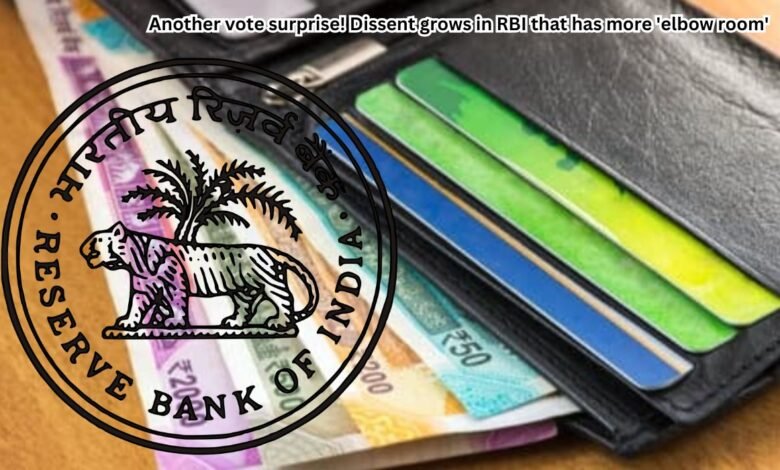Another vote surprise! Dissent grows in RBI that has more ‘elbow room’
Surprise vote! Growing dissent in RBI as it explores more 'elbow room' in policy decisions. Discover the implications.

Dissent grows in RBI that has more ‘elbow room’: Recent developments within the Reserve Bank of India (RBI) have captured attention due to unexpected voting outcomes and a growing wave of dissent among its members. Historically, the RBI has operated on a consensus-driven approach, where decisions on monetary policy were often reached with minimal disagreement. However, the current landscape is witnessing a shift, with notable instances of dissent becoming more frequent.
This newfound divergence in opinions among RBI members is indicative of a broader and more dynamic debate on the nation’s economic strategy. The term ‘elbow room’ in monetary policy refers to the flexibility and discretion that policymakers have to adjust interest rates and other instruments to address economic challenges. This concept is becoming increasingly relevant as India navigates complex economic conditions marked by fluctuating growth rates and inflationary pressures.
Recent voting patterns reveal a departure from the traditionally unified stance within the RBI. Members are voicing varied perspectives on the appropriate course of action. This dissent is significant as it reflects a deeper deliberation on how best to balance growth and inflation, and the means to achieve sustainable economic stability. The growing diversity in viewpoints suggests a more robust and transparent decision-making process, albeit one that introduces a degree of unpredictability.
The implications of this dissent are multifaceted. On one hand, it could lead to more innovative and flexible policy responses that are better suited to the dynamic economic environment. On the other, it may introduce uncertainty in the markets, as stakeholders grapple with the potential for less predictable monetary policy decisions. As the RBI navigates this evolving landscape, the increased ‘elbow room’ in policy-making could either be a boon or a challenge, impacting everything from interest rates to investor confidence.
Understanding ‘Elbow Room’ in Monetary Policy
The concept of ‘elbow room’ in monetary policy refers to the degree of flexibility and discretion that central banks, such as the Reserve Bank of India (RBI), have in shaping economic outcomes. This flexibility is crucial for central banks to respond effectively to varying economic conditions, ensuring stability and growth. When the RBI has more ‘elbow room,’ it can employ a range of monetary tools and strategies to address economic challenges.
Several key tools are available to the RBI when it possesses greater ‘elbow room’:
- Adjusting Interest Rates: The RBI can influence borrowing costs by modifying the repo rate, which affects inflation and economic activity.
- Modifying Reserve Requirements: By changing the cash reserve ratio (CRR) or statutory liquidity ratio (SLR), the RBI controls the amount of funds banks must hold in reserve, impacting their lending capacity.
- Implementing Quantitative Easing: The central bank can purchase government securities or other financial assets to inject liquidity into the economy, stimulating growth.
- Open Market Operations (OMO): Buying or selling government bonds in the open market helps manage liquidity and interest rates.
- Forward Guidance: Providing future policy direction to influence market expectations and behaviors.
To better understand the impact of these tools, consider the following comparison:
| Monetary Tool | Potential Impact |
|---|---|
| Adjusting Interest Rates | Directly affects borrowing costs, influencing consumer spending and investment. |
| Modifying Reserve Requirements | Alters the amount of funds banks can lend, affecting liquidity and credit availability. |
| Quantitative Easing | Increases money supply and lowers interest rates, boosting economic activity. |
| Open Market Operations | Helps control short-term interest rates and manage overall liquidity in the financial system. |
| Forward Guidance | Shapes market expectations and stabilizes economic outlook. |
Having more ‘elbow room’ allows the RBI to tailor its monetary policy actions to the specific needs of the economy, enhancing its capability to maintain financial stability and foster economic growth.
Dissent grows in RBI: Key Voices and Their Arguments
The Reserve Bank of India (RBI) has recently witnessed a surge in dissent among its members, reflecting a growing divide over the current monetary policies. These dissenting voices, coming from seasoned professionals within the institution, are raising significant concerns about the direction and effectiveness of the RBI’s strategies. The following profiles provide an insight into these key figures, their backgrounds, and their arguments.
Dr. Arvind Kumar
Dr. Arvind Kumar, a seasoned economist with over two decades of experience, has been particularly vocal about the RBI’s stance on interest rates. A proponent of more aggressive rate cuts, Dr. Kumar argues that the current conservative approach is stifling economic growth. He believes that lower interest rates would boost consumer spending and business investments, thereby revitalizing the economy.
- Stance: Advocates for aggressive rate cuts
- Main Argument: Current interest rates are hindering economic growth
- Key Quote: “An aggressive rate cut is crucial to stimulate the economy.”
Ms. Priya Sharma
Ms. Priya Sharma, with a robust background in financial markets, has expressed concerns over the RBI’s inflation targeting framework. She contends that an overemphasis on controlling inflation is limiting the central bank’s ability to address other critical issues such as unemployment and economic stagnation. Sharma suggests a more balanced approach that considers multiple economic indicators.
- Stance: Questions the focus on inflation targeting
- Main Argument: The current policy neglects broader economic challenges
- Key Quote: “A singular focus on inflation is myopic and detrimental.”
Dr. Sanjay Rao
Dr. Sanjay Rao, an expert in international economics, has raised alarms about the RBI’s foreign exchange policies. He argues that the current strategy, which heavily relies on maintaining high foreign exchange reserves, is not sustainable. Rao advocates for a more dynamic approach that balances reserve accumulation with other economic priorities, such as infrastructure investment and social welfare programs.
- Stance: Criticizes the focus on high foreign exchange reserves
- Main Argument: The policy is unsustainable and overlooks other priorities
- Key Quote: “A balanced approach is essential for long-term economic health.”
These dissenting voices within the RBI highlight the growing debate over the institution’s policies and their impact on the economy. Their arguments underscore the need for a more nuanced approach to monetary policy that considers a broader range of economic indicators and priorities.
Implications of the Dissent: What Lies Ahead for RBI and the Economy
The growing dissent within the Reserve Bank of India (RBI) signals potential shifts in the country’s monetary policy, which could have far-reaching implications for the Indian economy. As disagreements become more pronounced, the direction of interest rates, economic growth projections, and inflation rates may experience significant changes. These policy shifts are not only critical for the domestic economy but also for investor confidence and overall market stability.
One of the possible scenarios ensuing from this dissent is a change in interest rates. If the dissenting voices advocate for a more aggressive stance on controlling inflation, we might see an increase in interest rates. This could curb inflationary pressures but might also slow down economic growth. Conversely, if the emphasis shifts towards stimulating growth, a reduction in interest rates could be on the horizon, potentially boosting investment and consumption but risking higher inflation.
Another aspect to consider is the impact on economic growth projections. The dissent within the RBI could lead to a more cautious or optimistic outlook, depending on the prevailing sentiment among the policymakers. A conservative approach might result in lower growth forecasts, while a more expansionary policy could enhance growth prospects but with associated risks.
Inflation is another critical factor influenced by the RBI’s policy direction. Divergent views within the RBI could lead to mixed signals about inflation control measures, affecting both short-term and long-term inflation expectations.
The table below outlines the potential short-term and long-term effects of different policy changes:
| Policy Change | Short-term Effects | Long-term Effects |
|---|---|---|
| Increase in Interest Rates | Reduced inflation, slowed economic growth | Lower inflation expectations, potential economic stability |
| Decrease in Interest Rates | Boosted investment and consumption, increased inflation | Higher growth potential, risk of prolonged inflation |
| Conservative Economic Projections | Lower growth expectations, cautious investment | Potentially stable economic environment, slower growth |
| Optimistic Economic Projections | Enhanced growth prospects, increased market activity | Higher long-term growth, risk of economic overheating |
- IRB Infra shares surge 10% on increase in toll tax buzz
- Evan Davis: Successful entrepreneurs don’t worry about being different
- India’s agricultural revolution: Shaping the future through innovative farming practices
The dissent within the RBI also has implications for investor confidence and market stability. A transparent and well-communicated policy approach can mitigate uncertainties, while perceived discord could lead to market volatility. Investors closely monitor the RBI’s decisions, and any signs of disunity can affect market sentiments, influencing stock prices, bond yields, and the broader economic outlook.


